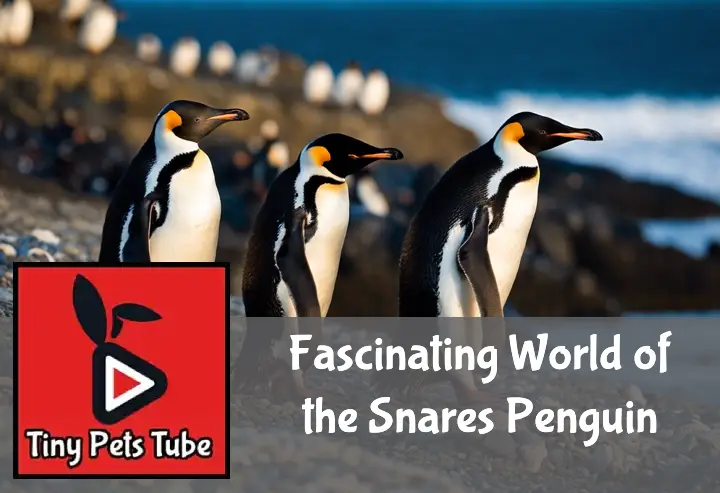Ever had one of those moments where you stumble upon a creature so unique, it makes you go “Wow, nature really went all out on this one”? Well, that’s exactly how I felt when I first discovered the Snares Penguin.
This little flightless bird is a bundle of surprises packed in a tuxedo! It’s not just their adorable waddle or their knack for swimming that caught my attention, but the fascinating world they inhabit. So buckle up folks, because we’re about to dive deep into the life of these charming creatures. Keep reading about Fascinating World of the Snares Penguin.
Key Takeaways
- The Snares Penguin is a unique species native to New Zealand’s Snares Islands.
- They are medium-sized penguins known for their distinctive crest of yellow feathers.
- Their diet primarily consists of squid, krill, and small fish.
- Unlike other penguin species, they breed in dense colonies on forest floors rather than ice.
- The Snares Penguin population is stable but vulnerable due to limited breeding locations and potential climate change impacts.

What is the Snares Penguin?
Well, let me tell you about this little gem of a bird. The Snares Penguin is a unique character in the penguin world. It’s got its own quirks and traits that make it stand out from the crowd of Antarctic birds.
Origin and Classification
Now, where did this funky fellow come from? The Snares Penguin was discovered on the Snares Islands, just south of New Zealand. These islands are home to some of the most unique wildlife, including our star here.
In terms of taxonomy, it’s classified under Eudyptes robustus. That’s right folks, this bird has its own category! Talk about being special. Its evolution is quite fascinating too, as it’s an endemic species to New Zealand.
Physical Characteristics
Let’s talk looks now. The Snares Penguin isn’t your average black and white birdie. It sports a dark plumage pattern with a white underbelly – very chic indeed! But what really sets it apart are those yellow crests above its eyes – talk about natural eyeliner!
Size-wise, they’re not too shabby either. They stand at around 50-70cm tall – not exactly towering over us humans but hey, good things come in small packages!
Lifespan and Growth
So how long does this stylish seabird live? Well, research findings suggest that these guys can live up to 20 years! That’s quite impressive for a little birdie living in harsh Antarctic conditions.
From chick to adult, their growth rates are pretty interesting too. They start off as fluffy chicks (aww!) and grow into sleek adults within just a few months during the breeding season.
Factors like food availability and predation can affect their lifespan though – life ain’t always easy for our feathery friends! But they’ve got some solid survival strategies up their sleeves, which is why we still get to enjoy their presence today.
Where does the Snares Penguin Live?
The Snares Penguin is a fascinating creature that has adapted to some of the most unique environments on Earth. It’s all about location, location, location for these guys!
Geographical Distribution
These flightless birds are exclusive residents of the Snares Islands, a group of rocky outcrops located in the Southern Ocean off New Zealand’s South Island. Talk about an exclusive neighborhood! This Snares Islands location is their only known breeding ground.
Interestingly, unlike other penguin species, Snares Penguins aren’t big on travel. They don’t have any significant migratory patterns or seasonal movements. Instead, they prefer to stick around their home turf year-round.
They’ve got it all figured out – why leave paradise when you’ve got everything you need right there? Their habitat exclusivity and lack of migration make them one of the most unique members of the penguin family.
Habitat and Climate
Now let’s talk about their crib – the typical environment and climate conditions that these cool birds thrive in. The Snares Islands offer a subantarctic climate which might not be everyone’s cup of tea but works perfectly for our feathered friends.
The islands’ rocky terrain provides ample nesting sites and protection from predators. These environmental adaptations are crucial for their survival and successful breeding seasons.
But it’s not all land-based living for these guys; they’re also partial to a bit of oceanic habitat action. They spend a considerable amount of time in the water hunting for food, playing Marco Polo with each other (probably), and just generally enjoying life as an aquatic bird.
Temperature influences on penguin life can’t be understated either. The cooler temperatures help keep their bodies at optimal functioning levels – too hot and they’d overheat due to their dense feather coverage.
So there you have it – life as a Snares Penguin is all about adapting to the unique conditions of their exclusive island home.

What are the Behaviors of the Snares Penguin?
The Snares Penguin is a fascinating creature, with behaviors that reveal a complex social life. From their unique social structure to their intriguing communication methods and mating rituals, these birds are truly captivating.
Social Structure and Interaction
The social behavior in Snares Penguins is quite remarkable. They live in colonies, exhibiting a clear hierarchy. The stronger penguins often occupy prime nesting spots, while the weaker ones settle for less desirable locations.
Interaction among these birds is a mix of cooperation and competition. For instance, they work together during hunting expeditions, but when it comes to securing the best nesting sites or mates, it’s every penguin for itself! This dynamic interplay between cooperation and competition makes their group dynamics incredibly interesting.
Communication Methods
Communication among Snares Penguins involves an array of vocalizations and body language cues. Their calls vary from loud trumpeting sounds to softer contact calls used for locating each other in crowded colonies.
Body language also plays a crucial role in their interaction. Flapping wings can signal excitement or agitation, while bowing often serves as a sign of submission or respect. These communication techniques are vital for their survival, helping them maintain order within the colony and coordinate activities like hunting and nesting.
Mating and Reproduction
When it comes to mating rituals, Snares Penguins put on quite a show! The courtship process involves elaborate displays of preening and flipper waving by males to attract females.
Once paired up, they engage in nest building behavior using pebbles and twigs. After laying eggs (usually two), both parents share incubation duties until the chicks hatch.
Rearing strategies involve both parents taking turns to feed the chicks until they’re ready to fend for themselves. Understanding this reproductive cycle offers fascinating insights into the life of these extraordinary birds on Snares Island.
What does the Snares Penguin Eat?
When it comes to chow time, the Snares Penguin isn’t picky. They’re all about that seafood life, with a diet mainly consisting of Antarctic krill, different fish species, and even some squid.
Diet Composition
Now let’s dive deeper into the Snares Penguin diet, shall we? The main course on their menu is Antarctic krill. These tiny shrimp-like creatures are like the popcorn of the sea for our penguin pals. They’re easy to catch and packed with nutrients.
But don’t think they only munch on krill all day. Variety is the spice of life after all! Fish types eaten by penguins include lanternfish and other small species that swim in schools. It’s like an all-you-can-eat sushi buffet out there!
And let’s not forget about squid. While not as common as krill or fish in their diet, these slippery critters do make an appearance from time to time. Squid dietary significance lies in their high protein content, making them a valuable meal when available.
Hunting Techniques
So how does a Snares Penguin snag its dinner? Well, it starts with a dive. And we’re not talking about a casual dip; these birds can reach impressive diving depths for hunting.
Once underwater, they can reach speeds that would make Michael Phelps jealous! This underwater speed in pursuit allows them to chase down swift prey like fish and squid.
Sometimes though, they prefer a more stealth approach to prey. By blending into their surroundings and moving slowly, they can sneak up on unsuspecting meals.
And when food is abundant near the surface? That’s when you’ll see some surface feeding behavior. Why bother diving deep when dinner is served right at your doorstep? Group hunting strategy also comes into play here as more eyes spotting food means everyone gets a share.
So there you have it, the fascinating world of Snares Penguin dining!
How does the Snares Penguin Adapt to its Environment?
The Snares Penguin is a true survivor, boasting an array of physical and behavioral adaptations that allow it to thrive in some of the harshest conditions on earth. These traits are not just for show, they play a crucial role in their feeding, breeding, and predator evasion.
Physical Adaptations
Ever wondered why Snares Penguins always look slick and shiny? That’s thanks to their waterproof feathers. These feathers provide insulation and buoyancy while swimming. They also have this nifty ability to trap air which aids in thermal regulation.
Now let’s talk about their body shape. Ever noticed how they’re built like little torpedoes? That streamlined body shape isn’t just for looks. It helps them cut through water with ease, making them efficient swimmers when hunting for food.
And then there are those adorable webbed feet! Not just cute accessories, these feet function as powerful flippers underwater. They help propel the penguin through water at impressive speeds – all part of the Snares Penguin morphology that makes them such successful survivors.
Behavioral Adaptations
When it comes to behavior, these penguins are no less fascinating. During breeding season, they form large colonies – a kind of social behavior in penguins that provides safety in numbers against predators.
Their feeding techniques are equally impressive. They dive deep into the ocean using their excellent swimming abilities to catch prey efficiently and safely. This strategy minimizes energy expenditure while maximizing food intake – pretty smart if you ask me!
Lastly, let’s not forget about their predator avoidance strategies. When danger looms, Snares Penguins use their speed and agility both on land and underwater to evade threats. Communal living benefits also come into play here as there’s always someone keeping an eye out for danger.
So there you have it! The world of the Snares Penguin is a testament to nature’s ingenuity, where every physical trait and behavior pattern contributes to their survival.
What Threats does the Snares Penguin Face?
Life ain’t always a beach party for our flippered friends, the Snares Penguins. They face a slew of threats, both from nature’s predators and us humans. But don’t fret! There are some top-notch conservation efforts in play to keep these little guys waddling.
Natural Predators
When it comes to natural predators, Snares Penguins have quite the hit list. Sea lions, skuas, and sharks – oh my! These critters see our penguin pals as tasty snacks. It’s a tough gig being at the bottom of the food chain.
But these penguins aren’t just sitting ducks… or should I say sitting penguins? They’ve got some nifty defense mechanisms up their sleeves (or flippers). For instance, they’re known to form tight groups when swimming – safety in numbers and all that jazz.
Human Impact and Conservation Efforts
Now onto us humans. We’re not exactly innocent in this story either. Our activities have had a pretty hefty impact on Snares Penguin populations. Pollution effects on wildlife are no joke, folks!
The fishing industry also poses a threat to these adorable waddlers. Overfishing can lead to food shortages for our feathered friends – not cool at all! But it’s not all doom and gloom.
There are some fantastic conservation strategies in place aimed at protecting these endangered penguins. Wildlife organizations worldwide are working tirelessly to ensure these birds continue to strut their stuff on the shores of New Zealand.
And guess what? Some of these protection programs have been super successful! So let’s hear it for human kindness and dedication – because without it, we might lose these fascinating creatures forever.

To Wrap Up
We’ve dived deep into the world of the Snares Penguin, a creature as fascinating as a magician pulling endless handkerchiefs from his sleeve. These penguins are like the secret agents of the avian realm, living in seclusion and thriving in harsh conditions.
So next time you’re feeling chilly, remember our tuxedoed friends braving icy waters with aplomb. Let’s appreciate their resilience and continue learning about their intriguing lives. After all, we could all use a bit of that Snares Penguin spirit!


